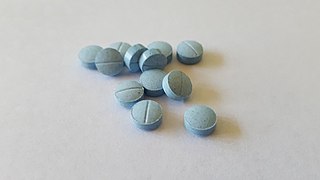Related Research Articles

Hypnotic, or soporific drugs, commonly known as sleeping pills, are a class of psychoactive drugs whose primary function is to induce sleep and to treat insomnia (sleeplessness).

Orexin, also known as hypocretin, is a neuropeptide that regulates arousal, wakefulness, and appetite. It exists in the forms of orexin-A and orexin-B. The most common form of narcolepsy, type 1, in which the individual experiences brief losses of muscle tone, is caused by a lack of orexin in the brain due to destruction of the cells that produce it.

Ramelteon, sold under the brand name Rozerem among others, is a melatonin agonist medication which is used in the treatment of insomnia. It is indicated specifically for the treatment of insomnia characterized by difficulties with sleep onset. It reduces the time taken to fall asleep, but the degree of clinical benefit is small. The medication is approved for long-term use. Ramelteon is taken by mouth.

SB-649868 is a dual orexin receptor antagonist that was being developed by GlaxoSmithKline as a treatment for insomnia.
The orexin receptor (also referred to as the hypocretin receptor) is a G-protein-coupled receptor that binds the neuropeptide orexin. There are two variants, OX1 and OX2, each encoded by a different gene (HCRTR1, HCRTR2).

Orexin receptor type 1 (Ox1R or OX1), also known as hypocretin receptor type 1 (HcrtR1), is a protein that in humans is encoded by the HCRTR1 gene.

Orexin receptor type 2 (Ox2R or OX2), also known as hypocretin receptor type 2 (HcrtR2), is a protein that in humans is encoded by the HCRTR2 gene.

Almorexant (INN), also known by its development code ACT-078573, is an orexin antagonist, acting as a competitive antagonist of the OX1 and OX2 orexin receptors, which was being developed by the pharmaceutical companies Actelion and GSK for the treatment of insomnia. Development of the drug was abandoned in January 2011 due to concerns over the hepatic safety of almorexant after transient increases in liver enzymes were observed in trials.

SB-334867 is an orexin antagonist. It was the first non-peptide antagonist developed that is selective for the orexin receptor subtype OX1, with around 50x selectivity for OX1 over OX2 receptors. It has been shown to produce sedative and anorectic effects in animals, and has been useful in characterising the orexinergic regulation of brain systems involved with appetite and sleep, as well as other physiological processes. The hydrochloride salt of SB-334867 has been demonstrated to be hydrolytically unstable, both in solution and as the solid. Orexin antagonists have multiple potential clinical applications including the treatment of drug addiction, insomnia, obesity and diabetes.

Esmirtazapine (ORG-50,081) is a tetracyclic antidepressant drug that was under development by Organon for the treatment of insomnia and vasomotor symptoms (e.g., hot flashes) associated with menopause. Esmirtazapine is the (S)-(+)-enantiomer of mirtazapine and possesses similar overall pharmacology, including inverse agonist actions at H1 and 5-HT2 receptors and antagonist actions at α2-adrenergic receptors.

Suvorexant, sold under the brand name Belsomra, is an orexin antagonist medication which is used in the treatment of insomnia. It is indicated specifically for the treatment of insomnia characterized by difficulties with sleep onset and/or maintenance in adults. Suvorexant helps with falling asleep faster, sleeping longer, being awake less in the middle of the night, and having better quality of sleep. Its effectiveness is modest, and is similar to that of other orexin antagonists, but is lower than that of benzodiazepines and Z-drugs. Suvorexant is taken by mouth.

EMPA is a selective antagonist of the OX2 receptor, with 900-fold selectivity in binding for OX2 over OX1.

Filorexant (INNTooltip International Nonproprietary Name, USANTooltip United States Approved Name; developmental code name MK-6096) is an orexin antagonist which was under development by Merck for the treatment of insomnia, depression, diabetic neuropathy, and migraine. It is a dual antagonist of the orexin OX1 and OX2 receptors. It has a relatively short elimination half-life of 3 to 6 hours. However, it dissociates slowly from the orexin receptors and may thereby have a longer duration. Possibly in relation to this, filorexant shows next-day somnolence similarly to suvorexant. In phase 2 clinical trials, filorexant was found to be effective in the treatment of insomnia, but was not effective in the treatment of major depressive disorder, painful diabetic neuropathy, or migraine. As of May 2015, filorexant was no longer listed on Merck's online development pipeline and hence development of the drug appears to have been discontinued. Development of filorexant may have been discontinued due to lack of differentiation from suvorexant (which was also developed by Merck).

Seltorexant, also known by its developmental code names MIN-202 and JNJ-42847922, is an orexin antagonist medication which is under development for the treatment of depression and insomnia. It is a selective antagonist of the orexin OX2 receptor (2-SORA). The medication is taken by mouth. As of February 2022, seltorexant is in phase 3 clinical trials for treatment of major depressive disorder (MDD) and phase 2 trials for treatment of insomnia. It was also under investigation for the treatment of sleep apnea, but no recent development has been reported for this indication. Seltorexant is under development by Minerva Neurosciences and Johnson & Johnson's Janssen Pharmaceuticals.

Lemborexant, sold under the brand name Dayvigo, is an orexin antagonist medication which is used in the treatment of insomnia. It is indicated specifically for the treatment of insomnia characterized by difficulties with sleep onset and/or maintenance in adults. The medication is taken by mouth.

Daridorexant, sold under the brand name Quviviq, is an orexin antagonist medication which is used for the treatment of insomnia. Daridorexant is taken by mouth.

Vornorexant, also known by its developmental code names ORN-0829 and TS-142, is an orexin antagonist medication which is under development for the treatment of insomnia and sleep apnea. It is a dual orexin OX1 and OX2 receptor antagonist (DORA). The medication is taken by mouth. As of June 2021, vornorexant is in phase 2 clinical trials for insomnia and phase 1 trials for sleep apnea. It is under development by Taisho Pharmaceutical.

Firazorexton (INNTooltip International Nonproprietary Name; development code TAK-994) is an experimental orexin 2 (OX2) receptor agonist first described in a 2019 patent filed by Takeda Pharmaceutical Company.

ACT-539313 is an orexin antagonist medication which is under development for the treatment of binge eating disorder and was previously under development for the treatment of anxiety disorders. It is an orally active small-molecule compound with an elimination half-life of 3.3 to 6.5 hours and acts as a selective orexin OX1 receptor antagonist (1-SORA). As of May 2022, the drug is in phase 2 clinical trials for binge eating disorder. Following negative efficacy results of a phase 2 trial of ACT-539313 for binge eating disorder, Idorsia (the developer of ACT-539313) signaled in May 2022 that it would not pursue further development of the drug for this indication.

Somnifacient, also known as sedatives or sleeping pills, is a class of medications that induces sleep. It is mainly used for treatment of insomnia. Examples of somnifacients include benzodiazepines, barbiturates and antihistamines.
References
- ↑ Mogavero MP, Silvani A, Lanza G, DelRosso LM, Ferini-Strambi L, Ferri R (2023-01-22). "Targeting Orexin Receptors for the Treatment of Insomnia: From Physiological Mechanisms to Current Clinical Evidence and Recommendations". Nature and Science of Sleep (Review). 15: 17–38. doi: 10.2147/NSS.S201994 . PMC 9879039 . PMID 36713640.
- ↑ Roecker AJ, Coleman PJ (2008). "Orexin receptor antagonists: medicinal chemistry and therapeutic potential". Current Topics in Medicinal Chemistry. 8 (11): 977–987. doi:10.2174/156802608784936746. PMID 18673167.
- ↑ Cao M, Guilleminault C (April 2011). "Hypocretin and its emerging role as a target for treatment of sleep disorders". Current Neurology and Neuroscience Reports. 11 (2): 227–234. doi:10.1007/s11910-010-0172-9. PMID 21170610. S2CID 42562238.
- 1 2 3 Preskorn SH (January 2023). "Comparative Pharmacology of the 3 Marketed Dual Orexin Antagonists-Daridorexant, Lemborexant, and Suvorexant-Part 2. Principal Drug Metabolizing Enzyme, Drug-Drug Interactions, and Effects of Liver and Renal Impairment on Metabolism". Journal of Psychiatric Practice. 29 (1): 38–41. doi:10.1097/PRA.0000000000000690. PMID 36649550. S2CID 255944492.
- ↑ "Daridorexant - Idorsia Pharmaceuticals". AdisInsight. Springer Nature Switzerland AG.
- ↑ Ziemichód W, Grabowska K, Kurowska A, Biała G (September 2022). "A Comprehensive Review of Daridorexant, a Dual-Orexin Receptor Antagonist as New Approach for the Treatment of Insomnia". Molecules. 27 (18): 6041. doi: 10.3390/molecules27186041 . PMC 9502995 . PMID 36144776.
- 1 2 3 4 Keks NA, Hope J (August 2022). "Lemborexant, an orexin receptor antagonist sedative-hypnotic: Is it useful for insomnia in psychiatric disorders?". Australasian Psychiatry. 30 (4): 530–532. doi:10.1177/10398562221092310. PMID 35491942. S2CID 248494625.
- 1 2 3 Muehlan C, Vaillant C, Zenklusen I, Kraehenbuehl S, Dingemanse J (November 2020). "Clinical pharmacology, efficacy, and safety of orexin receptor antagonists for the treatment of insomnia disorders". Expert Opinion on Drug Metabolism & Toxicology. 16 (11): 1063–1078. doi:10.1080/17425255.2020.1817380. PMID 32901578. S2CID 221572078.
- 1 2 Xu S, Cui Y, Shen J, Wang P (July 2020). "Suvorexant for the prevention of delirium: A meta-analysis". Medicine. 99 (30): e21043. doi:10.1097/MD.0000000000021043. PMC 7386982 . PMID 32791676.
- 1 2 Tian Y, Qin Z, Han Y (March 2022). "Suvorexant with or without ramelteon to prevent delirium: a systematic review and meta-analysis". Psychogeriatrics. 22 (2): 259–268. doi:10.1111/psyg.12792. PMID 34881812. S2CID 245076331.
- ↑ Sutton EL (2015-11-11). "Profile of suvorexant in the management of insomnia". Drug Design, Development and Therapy. 9: 6035–6042. doi: 10.2147/DDDT.S73224 . PMC 4651361 . PMID 26648692.
- ↑ "Seltorexant - Janssen Research & Development/Minerva Neurosciences". AdisInsight. Springer Nature Switzerland AG.
- ↑ "Vornorexant - Taisho Pharmaceutical". AdisInsight. Springer Nature Switzerland AG.
- ↑ "Almorexant". AdisInsight. Springer Nature Switzerland AG.
- ↑ "Filorexant". AdisInsight. Springer Nature Switzerland AG.
- ↑ Rodgers RJ, Halford JC, Nunes de Souza RL, Canto de Souza AL, Piper DC, Arch JR, et al. (April 2001). "SB-334867, a selective orexin-1 receptor antagonist, enhances behavioural satiety and blocks the hyperphagic effect of orexin-A in rats". The European Journal of Neuroscience. 13 (7): 1444–1452. doi:10.1046/j.0953-816x.2001.01518.x. PMID 11298806. S2CID 24935644.
- 1 2 Xue T, Wu X, Chen S, Yang Y, Yan Z, Song Z, et al. (February 2022). "The efficacy and safety of dual orexin receptor antagonists in primary insomnia: A systematic review and network meta-analysis". Sleep Medicine Reviews. 61: 101573. doi:10.1016/j.smrv.2021.101573. PMID 34902823. S2CID 244689706.
- 1 2 Kuriyama A, Tabata H (October 2017). "Suvorexant for the treatment of primary insomnia: A systematic review and meta-analysis". Sleep Medicine Reviews. 35: 1–7. doi:10.1016/j.smrv.2016.09.004. PMID 28365447.
- 1 2 Kishi T, Matsunaga S, Iwata N (2015). "Suvorexant for Primary Insomnia: A Systematic Review and Meta-Analysis of Randomized Placebo-Controlled Trials". PLOS ONE. 10 (8): e0136910. Bibcode:2015PLoSO..1036910K. doi: 10.1371/journal.pone.0136910 . PMC 4552781 . PMID 26317363.
- 1 2 Kishi T, Nomura I, Matsuda Y, Sakuma K, Okuya M, Ikuta T, et al. (September 2020). "Lemborexant vs suvorexant for insomnia: A systematic review and network meta-analysis". Journal of Psychiatric Research. 128: 68–74. doi:10.1016/j.jpsychires.2020.05.025. PMID 32531478. S2CID 219620600.
- 1 2 McElroy H, O'Leary B, Adena M, Campbell R, Monfared AA, Meier G (September 2021). "Comparative efficacy of lemborexant and other insomnia treatments: a network meta-analysis". Journal of Managed Care & Specialty Pharmacy. 27 (9): 1296–1308. doi: 10.18553/jmcp.2021.21011 . PMC 10394202 . PMID 34121443.
- ↑ Wang L, Pan Y, Ye C, Guo L, Luo S, Dai S, et al. (December 2021). "A network meta-analysis of the long- and short-term efficacy of sleep medicines in adults and older adults". Neuroscience and Biobehavioral Reviews. 131: 489–496. doi: 10.1016/j.neubiorev.2021.09.035 . PMID 34560134. S2CID 237589779.
- ↑ "Belsomra- suvorexant tablet, film coated". DailyMed. U.S. National Library of Medicine. Retrieved 30 January 2020.
- ↑ "Dayvigo- lemborexant tablet, film coated". DailyMed. U.S. National Library of Medicine. Retrieved 17 June 2021.
- ↑ "Quviviq (daridorexant) tablets, for oral use, [controlled substance schedule pending]" (PDF). U.S. Food and Drug Administration (FDA). Retrieved 3 March 2022.
- ↑ Earl DC, Van Tyle KM (November 2020). "New pharmacologic agents for insomnia and hypersomnia". Current Opinion in Pulmonary Medicine. 26 (6): 629–633. doi:10.1097/MCP.0000000000000722. PMID 32890017. S2CID 221511561.
- ↑ Uchiyama M, Kambe D, Imadera Y, Sunaga H, Hasegawa S, Nogi T, et al. (April 2020). "0146 Efficacy and Safety of Single Dose of TS-142, a Novel and Potent Dual Orexin Receptor Antagonist, in Insomnia Patients". Sleep. 43 (Supplement 1): A58. doi: 10.1093/sleep/zsaa056.144 . eISSN 1550-9109. ISSN 0161-8105.
- 1 2 Ziemichód W, Grabowska K, Kurowska A, Biała G (September 2022). "A Comprehensive Review of Daridorexant, a Dual-Orexin Receptor Antagonist as New Approach for the Treatment of Insomnia". Molecules. 27 (18): 6041. doi: 10.3390/molecules27186041 . PMC 9502995 . PMID 36144776.
- ↑ Preskorn SH (January 2023). "Comparative Pharmacology of the 3 Marketed Dual Orexin Antagonists-Daridorexant, Lemborexant, and Suvorexant-Part 2. Principal Drug Metabolizing Enzyme, Drug-Drug Interactions, and Effects of Liver and Renal Impairment on Metabolism". Journal of Psychiatric Practice. 29 (1): 38–41. doi:10.1097/PRA.0000000000000690. PMID 36649550. S2CID 255944492.
- ↑ Sutton EL (2015-11-11). "Profile of suvorexant in the management of insomnia". Drug Design, Development and Therapy. 9: 6035–6042. doi: 10.2147/DDDT.S73224 . PMC 4651361 . PMID 26648692.
- ↑ Muehlan C, Vaillant C, Zenklusen I, Kraehenbuehl S, Dingemanse J (November 2020). "Clinical pharmacology, efficacy, and safety of orexin receptor antagonists for the treatment of insomnia disorders". Expert Opinion on Drug Metabolism & Toxicology. 16 (11): 1063–1078. doi:10.1080/17425255.2020.1817380. PMID 32901578. S2CID 221572078.
- ↑ Janto K, Prichard JR, Pusalavidyasagar S (August 2018). "An Update on Dual Orexin Receptor Antagonists and Their Potential Role in Insomnia Therapeutics". Journal of Clinical Sleep Medicine. 14 (8): 1399–1408. doi:10.5664/jcsm.7282. PMC 6086961 . PMID 30092886.
- ↑ Summers CH, Yaeger JD, Staton CD, Arendt DH, Summers TR (March 2020). "Orexin/hypocretin receptor modulation of anxiolytic and antidepressive responses during social stress and decision-making: Potential for therapy". Brain Research. 1731: 146085. doi:10.1016/j.brainres.2018.12.036. PMC 6591110 . PMID 30590027.
- ↑ Han Y, Yuan K, Zheng Y, Lu L (April 2020). "Orexin Receptor Antagonists as Emerging Treatments for Psychiatric Disorders". Neuroscience Bulletin. 36 (4): 432–448. doi:10.1007/s12264-019-00447-9. PMC 7142186 . PMID 31782044.
- 1 2 Jacobson LH, Hoyer D, de Lecea L (May 2022). "Hypocretins (orexins): The ultimate translational neuropeptides". Journal of Internal Medicine. 291 (5): 533–556. doi:10.1111/joim.13406. PMID 35043499. S2CID 248119793.
- ↑ Shariq AS, Rosenblat JD, Alageel A, Mansur RB, Rong C, Ho RC, et al. (June 2019). "Evaluating the role of orexins in the pathophysiology and treatment of depression: A comprehensive review". Progress in Neuro-Psychopharmacology & Biological Psychiatry. 92: 1–7. doi:10.1016/j.pnpbp.2018.12.008. PMID 30576764. S2CID 56482209.
- ↑ Clinical trial number NCT02669030 for "A Six Week, Randomized, Double-Blind Placebo-Controlled, Suvorexant Augmentation Study of Antidepressant Treatment of Major Depressive Disorder With Residual Insomnia" at ClinicalTrials.gov